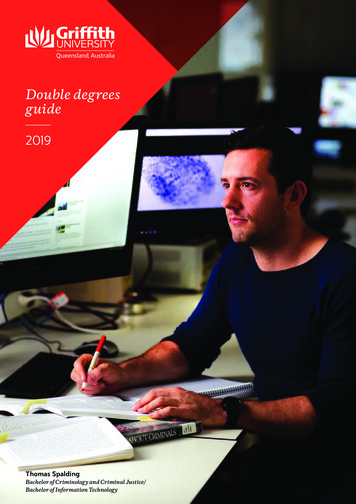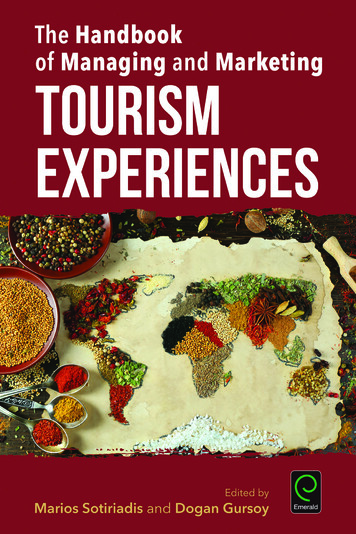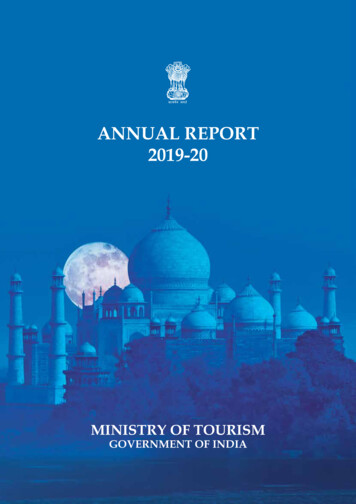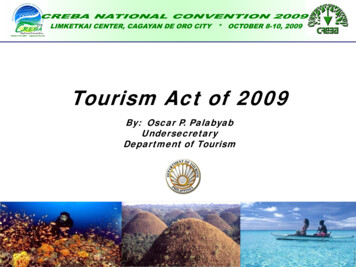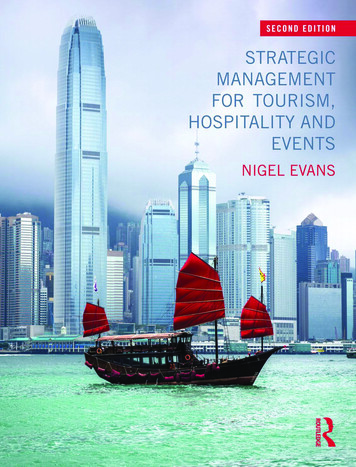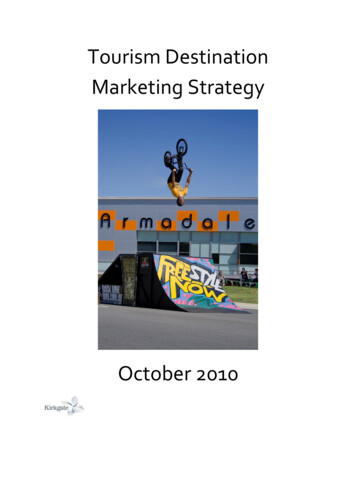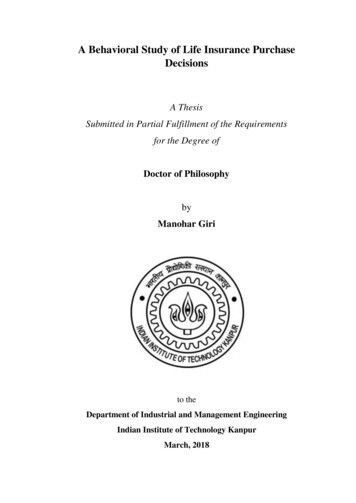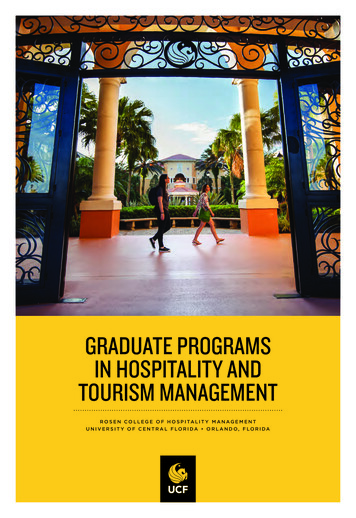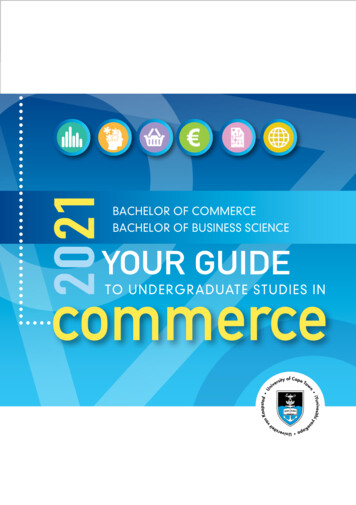
Transcription
Bachelor Thesis in Tourism StudiesDestination Image in Beijing, ChinaExploring the Differences in Destination Branding Toward International andDomestic TouristsDegree Project nr:Author: Chang Liu, Haoyuan NingSupervisor: Christina EngströmExaminer: Susanna Heldt CasselSubject: Human GeographyHögskolan Dalarna791 88 FalunHigher education credits: 15 hpDate of result: 2014-06-17SwedenTel 023-77 80 00
AbstractTourism destination marketing is one vital factor that affects the development andmanagement of destination images. This thesis deals with the destination images of Beijing andits branding strategies towards international tourists and domestic tourists. The purpose of thisthesis is to identify how Beijing is presented in tourism marketing between international touristsand domestic tourists, and to detect potential differences as well as reasons for them.This study focuses on analyzing Beijing’s marketing materials that include websites,brochures and videos towards international and domestic tourists by content analysis. An earlierstudy performed by Lew and Yu, 1992, found that international and domestic tourists showdifferent demands in China; thus this study continues an investigation to find whether thedifferent demands of international tourists and domestic tourists are considered in current Beijingmarketing materials, and if so, in what way.To fulfill the research purpose a series of destination images and different marketingstrategies from marketing materials towards international tourists and domestic tourists areidentified through the content analysis. With these findings, Beijing’s current marketingstrategies are clarified according to the potential differences towards the international anddomestic tourists.Keywords: Beijing tourism, branding, destination image, international and domestic tourist,tourism marketing, content analysis.
Table of Contents1.Introduction . 11.1Problem Statement . 11.2Research Purpose . 31.3Research Questions . 31.4Thesis Outline . 42. Research Background . 52.1 Beijing in Context . 53. Frame of Reference . 83.1 Tourism in China . 83.2 Definition of Destination Image . 103.3 Destination Branding. 113.4 Destination Branding and Image: A Reciprocal Relation . 133.5 Branding Process . 154. Methodology . 184.1Defining Content Analysis . 184.2 Sampling and Data Collection. 194.3Categorization . 204.4 Data analysis . 214.5 Actual Process in This Study . 224.6 Limitations . 265. Findings . 275.1 Original Outcomes . 275.2 Categories of Beijing Images . 29
6. Analysis and Discussion . 326.1 Destination images of Beijing . 326.2 Differences in Marketing Strategy . 346.3 Reasons behind the Differences . 387. Research Conclusion . 407.1 Conclusion . 407.2 Research Contributions . 417.3 Future Research Suggestions . 41Appendix . 46Appendix Figures . 46Appendix Tables . 51Appendix data . 52
Table of FiguresFigure 1: Destination Image and Destination Branding . . .14Table 1: The five phases in destination branding . . . 16Figure 2. Branding key links . . . .17Figure 3. Conceptual formation processes of Beijing’s tourism marketing materials that inEnglish version 23Figure 4. Conceptual formation processes of Beijing’s tourism marketing materials that inChinese version 24Table 2. Representative groups (original results) in International and Domestic Marketingmaterials .27Figure 5. Percentages in International and domestic marketing materials .281
1. Introduction1.1 Problem StatementTourism is a social and economic phenomenon that heavily influences contemporarysociety (Crick, 1996). Nowadays, tourism industry can be considered as business behavior sinceit might influence the development of a local economic. Therefore, places are competing againsteach other to promote themselves as goods. The secret for a successful destination is to approachthe right target market and to provide an appropriate combination of local tourism products andservices (Buhalis, 2000). Pick’s (2005) argues that there will be a battle of destinations brandingin future marketing; destinations are arguably to become the tourism industry’s biggest brands.Tourism destination branding is a general concept; destinations can be branded likeproducts or people. In this case, the power of branding is in making people aware of the locationand linking desirable associations (Damnjanović, Kravic and Abdul Razek, n.d.). Destinations area large entity with sets of material and non-material elements (Florek, 2005). Every destination isunique because its resources construct a unique ‘identification’. This ‘identification’ is usuallyrecognized as the images projected to tourists. The images a specific destination offers may besimilar to others but never the same. Strategies of building ‘identification’ influence thedestination images and thus will influence its future planning; to the end, they will affectdestination development. Elements of a destination are the foundation of destination; theygenerate the ‘identification’ and finally build up the destination image. What matters here is theways in which the destination generates the ‘identification’ or in other words the ways ofbranding. Destination branding can be defined as a way to communicate a destination’s uniqueidentity by differentiating a destination from its competitors (Morrison & Anderson, 2002 cited inQu, Kim, and Im, 2011, pp. 465--476).In destination branding, it is essential to understand consumer perceptions of the destination(Anholt, 2009). Different target consumers have different perceptions, they can be divided bytheir characteristics, such as sex, age, region or nationality. As discussed by Lew and Yu (1995)in early Chinese tourism there are different demands between international and domestic tourists.1
These two different tourist groups have unique preferences in selecting tourism destinations; it isunknown if such differences still remain and if they are considered in tourism marketing today(ibid).During the start of international tourism in China between 1978 to June 1989, Chinesetourism was a seller’s market with more than a sufficient supply of tourists, the quality andvariety of tourist attractions mattered little. National Tourism Administration of China (NTA)shows that there had been no supporting research on either marketing or tourists in the firstdecade of Chinese tourism. Most of the decision on selecting tourist attractions to open forforeigners were made either by copying patterns found in other countries or by best guessassumptions and common sense judgments (Lew and Yu, 1995). The late start of tourismdevelopment has influenced China even up until today. In the early stages of Chinese tourism, theChinese authorities sold the country to foreign tourists through images of a “mystical country”.These images were not based on sophisticated research of tourists markets or internationalvisitors to China, subsequently did not reflect visitor’s true experience of the Chinese landscape(Lew and Yu, 1995). With the growing numbers of studies in the tourism domain, more strategiesin image branding are being created because of increasing demand in tourism industry.According to The Australian News (2014), China has been the fourth largest source countryfor international tourism, and it is the fastest growing market. China’s capital city, Beijing acts aspolitical, economic, educational, cultural, and international trade center for the country. It attracts140 million domestic tourists and 4.4 million international tourists each year. Beijing is the firstchoice among domestic tourists; it usually serves as the first station of arriving internationaltourists. With such high travel flows of both tourists groups, the city’s destination branding hasbecome increasingly urgent and significant. Strategies behind marketing will greatly affecttourists perceptions of Beijing. This thesis seeks to identify Beijing’s destination branding andthe strategies currently used through content analyzing the city’s marketing materials.2
1.2Research PurposeEarlier studies reveal that domestic and international tourists have different demands whenit comes to tourism in China (e.g. Lew and Yu, 1995). This thesis seeks to investigate whetherthese differences are considered in current marketing material of Beijing, and if so, in what way.Thus, the purpose of this thesis is to identify how Beijing is presented in tourism marketingtowards international and domestic tourists, and to detect potential differences as well as reasonsfor this. The study is conducted using content analysis, where the city’s tourism-marketingmaterials: official websites, Medias and tourism brochure are analyzed. By analyzing thestructure, patterns and emphasis of these marketing materials, the aspiration is to gain anunderstanding of the city’s destination branding strategy towards the two different tourists groups.To achieve the purpose we shall:1. Clarify how Beijing promotes itself as a touristic destination through marketingmaterials.2. Draw out the potential differences in marketing strategies towards international anddomestic tourists.1.3Research QuestionsTo fulfill the stated research purpose, two research questions are designed in order to guidethe research process:1. What categorizes the images used by Beijing destination branding to domestic andinternational tourists? Which are the most used images among the domestic andinternational tourist categories?2. What potential differences can be detected in marketing strategies toward domestic andinternational tourists?3
1.4Thesis OutlineIn order to gain a clear structure of this thesis, this outline is created to briefly introduce theresearch’s chapters. Chapter 2 – Research Background. This chapter introduces the reader with insight to theBeijing context; the chapter’s contents clarify the reason for this study. Chapter 3 – Frame of Reference. Provides a brief background of tourism in China. Itcontinues by presenting the main concepts of destination branding and images whichare used as the framework for the research findings and discussion. Chapter 4 - Methodology. This chapter presents the research methods chosen to meetthe research purpose. It includes the concept of content analysis, key steps of usingcontent analysis, data collection method and actual process of the study. The chapterconcludes by discussing the research limitations. Chapter 5 - Findings. Presents the results of collected data. Chapter 6 – Analysis and Discussion. This chapter records the analysis and discussionof the research findings in connection to the Frame of Reference concepts. Chapter 7 – Research Conclusion. The chapter draws a summary of the whole study; itpresents the research conclusion, whereby answering the research questions, and closeswith suggestions for future research.4
2. Research BackgroundThe research foreground utilizes Beijing as the target destination, i.e. focus of the study.Therefore, this chapter will introduce Beijing in Context, as it provides background informationof the target destination and the reason for having this study.2.1 Beijing in ContextBeijing, the capital city of China has a history of approximately three thousand years.Beijing covers 16,808 square kilometres in area, it has a population of 11 million; it serves as thepolitical, cultural and economic centre of the People's Republic of China (Beijing Travel, 2014).During its history, Beijing has been the political centre of the country for much of the past eightcenturies. King Wu first declared the city as the capital in 1057 BC. After that, the city underwentname changes from Ji to Zhongdu, Dadu, and finally Beijing during the Ming dynasty byEmperor Chengzu in 1421. Before 1949, Beijing was known as Peking by the Western world(The Beijing Page, 2014).Beijing’s long history contains a rich heritage and cultural relics, examples of sites andattractions are the Great Wall, the Forbidden City, Summer Palace, Temple of Heaven, theHutong (narrow bystreets), Siheyuan (quadrangle courtyard), Pedi cab (Beijing Travel, 2014). Allthese examples are unique symbols of Beijing, which project an image of history or culture1.Since the early 1980s, China initiated economic and market reforms under the late DengXiaoping, Beijing became a truly economical and modern city (The Beijing Page, 2014). The cityrapidly developed after that, especially the tertiary industry. Beijing had a GDP of 17879.4Billion RMB in 2012 and the tertiary industry accounts for 76% of the GDP (Statistics China,2014). By the end of 2007, there were 751 financial organizations in Beijing, and they created128.6 billion RMB revenues accounting for 11.6% of the total financial industry revenue for allof China (Beijing Travel, 2014).1Historical/cultural: Each type of attraction has its own unique combination of benefits and advantages; some focusmore on the historical aspect, some on the cultural, and others mix geographic and heritage elements (Bonn et al.,2007). In this study, the different destination images (Historical, cultural, international, shopping, modern, artistic) aswell as the attributes/elements the images contain are simply the features that marketing materials attempt to presentto tourists.5
In the past twenty years, Beijing has experienced a huge development in economy, leadingtowards a great impact on city construction. Skyscrapers, shopping malls, office blocks, and bighotels have been rising like trees. Contemporary music clubs, discos thrive in an era ofliberalization and prosperity, mixed with modernity into the image of Beijing. Consequently, thecity faces an internationalization process; growing interactions between Beijing and the world areincreasing the city’s cultural integration, internalization, and modernity.Beijing acquired the right to host 2008’s Olympic Games. Olympic facilities like thestadium “Nest”, “Water Cube” demonstrate large attractions in Beijing. To the end 2012, therewas 5.01 million international tourists that stayed overnight in Beijing (Statistics China, 2014).Nowadays, foreign tourists can be seen on the streets of Beijing. With the increasingdevelopment and international communication activities, the city has become international.Tourism is a sector that is rising and will continue to grow in the future. Beijing is acomplex mix of tourism elements with different perspectives; it is attractive to both domestic andinternational tourists. Tourism as one of the leading sectors of the tertiary industry that hasbrought Beijing impressive development; to the end of year 2012, international tourists brought anumber of 5149 million US dollars to the local economy (Statistics China, 2014).Beijing is on the path towards becoming an attractive tourism destination; its use of imagesto different tourists may be different though. Until today, there is no clear definition aboutBeijing’s unique identity that is branded to tourists. Tourists can perceive marketing materialsimages in many different ways. Consequently, information gathered by tourists is alwaysunclassified. There is a lack of a structured, completed overall destination image throughBeijing’s tourism marketing; as a result, it is difficult to see the branding strategies.Many tourists go to Beijing for a general experience of China, but never really realize whattypes of Beijing they have perceived. As the identification of Beijing, the branding matters notonly tourists’ decision making, but also the images that will be built, and relative strategies forfuture planning of Beijing. For these reasons, on asks: How is Beijing presenting itself? Amongall those historical, cultural, political, economic, modern, and international elements, which oneis Beijing emphasizing? What category of destination images is Beijing generating? Is there adifference between marketing to domestic and international tourists? The answers to these6
questions are displayed through the local marketing methods, and are subconsciously generatedin tourists’ mind. In this process, what is shown to tourists makes people curious.It could be meaningful to have an analysis of Beijing destination marketing, to classify andcategorize themes that are branded to tourists. This research can also help Beijing to review itself,and critically evaluate its branding strategies. Thus, this study is motivated, and related to thetheoretical support from the thesis’ Chapter 3 (Frame of Reference), and an appropriate researchmethod that shall aid to fulfil the research purpose and answer the research questions.7
3. Frame of ReferenceThe first part of this chapter offers brief characteristics of international and domestictourists in China; it presents the key knowledge that works as mirror to reveal the potentialdifferences between different tourist groups and guides the results of this study. Furthermore, thischapter offers a look at two concepts: destination image and destination branding that serves asthe Frame of Reference, which are subsequently used to support this study. The chapter describesthe relationship between the two concepts, along with the branding process.To close the chapter we present the branding process because it offers our research thenecessary information needed to enhance the understanding of destination image and destinationbranding. However, it must be noted that the branding process simply serves as backgroundknowledge.3.1 Tourism in ChinaThe modern tourism in China was initiated in the 1920s but was rather short lived.However, relative to the birth of the People’s Republic in 1949, the development of tourismrestarted. The travelling in that time was restricted and only provided services for visitingoverseas Chinese residents and for foreigners with special permission to visit China. The yearthat the door of tourism really opened up was in 1978 (Lew and Yu, 1995).Already in the beginning of the opening door, international tourists showed huge interestsin two main areas: Eastern heartland and ethnic minority peripheral regions. Eastern heartlandrefers to sights of Chinese history and art, including e.g. Beijing, the Ming Emperors’ Tombs,and the Great Wall. Package tours, official trips, airline and shipping crews, private visits werethe main travel types in that time (Lew and Yu, 1995). Domestic tourism was discouraged bygovernment due to the unmatched tourism facilities with demands in early time since governmentaimed to satisfy overseas tourists first. But later on, when the important economic benefit andpotential was found in domestic tourism, it was growing fast. Erdmann (1995, cited in Lew andYu, 1995, p.131) stated that during his observations toward Chinese domestic tourists, herevealed not only overcrowd in all means of transportation, but also tourists squeezing8
themselves into museums, parks and so on. It was estimated that the amount of domestic touristswere approximately twenty times more than the international tourists (Lew and Yu, 1995).Early studies found that the behaviour of domestic Chinese tourists showed importantdifferences compared to international tourists (Lew and Yu, 1995). Domestic tourists, includingboth local and regional were more likely to predominate Chinese traditional gardens andrenovated monasteries. The cultural and natural landscape peculiarities of peripheral regions werestrong attractions for international tourists while domestic Chinese tourists showed less interestfor such attractions. An early observation of Yunnan province in China revealed that there wereobviously more domestic tourists in any attractions and they had higher average nights of staythan international tourists. And in this observation, Yunnan was regarded as less interestingamong the majority Han Chinese due to Yunnan’s remoteness and independent culture (Lew andYu, 1995). Later observations from Lew and Yu (1995) found that, though domestic tourists wereusually higher in amount than international tourists, the general trend was still that domestictourists preferred modern, seaside resorts rather than minority periphery regions. This wasexplained by the assumed aspiration of developed and wealthy areas. There was also anobservation by Lew and Yu (1995) revealed that lack of access (or in other word lack of money)could make domestic tourists hard to visit some destinations in China. For instance Guilin proveddifficulties in rising the amount of domestic tourists, because of high costs. Even by the time Lewand Yu published their observations, the easy access to Guilin was still by air and domestictourists could barely afford that.Despite the characteristics caused by the unbalanced and later developments, there are alsocultural differences. Lew and Yu (1995) found that Chinese themselves had deeply heldideological preconceptions of what the Chinese landscape image was and these preconceptionsmade the Chinese people see the landscape differently compared to foreigners. Westernersseemed to find it difficult to identify the cultural roots of each idea or image in the volumes ofChinese tourist brochures, while Chinese treated promotional images and culture as commonknowledge.It is difficult to separate the influence of images from Chinese people’s lives and toappreciate landscape without preconditioned thoughts. A Chinese river might just be a waterwayfor western tourists, while Chinese tourists might associate the river to a poem. International9
tourists are more pragmatic since they are not nurtured in the same cultural environment asdomestic Chinese tourists; it is difficult for international tourists to completely understandChinese tourists’ full experience of a place (Lew, 1992). Preconceptions affect the Chinese and ithas become a serious problem for Chinese tourism that the judgements and decisions on tourismdevelopment and promotions are generally made to reflect Chinese values, which includespreconditioned ‘common knowledge’ about foreigners and their tastes of landscape (Lew and Yu,1995). Such cultural bias makes decision makers overlook the reality of a landscape (Lew and Yu,1995).Significant differences exist between the destinations targeted by international tourism inChina and those of Chinese domestic tourism. Even to the same destination, international touristsand domestic tourists are usually motivated for different reasons. Lew and Yu (1995) stated thattrips made by international visitors often were arranged by the China International Travel Service(CITS). Western tourists more frequently visited minority frontiers and were perceived as moreadventurous and interested in exotic attractions than the Chinese. In contrast to internationalvisitors, domestic Chinese trip is a voluntary decision, similar like a pilgrimage to historical,cultural and political centres (Lew and Yu, 1995). Chinese tourists prefer to validate the poeticknowledge of places like traditional gardens. The different preferences among domestic andinternational tourists can be illustrated by statistical data from 1989, showing that 99percent ofthe visitors coming to Tibet were westerners. The absence of Chinese visitors reveals the culturalinfluence of the domestic tourist’s perception of remote places; it may also be because of thedisdain for minorities among the dominant Han Chinese (Lew and Yu, 1995).3.2 Definition of Destination ImageDestination image is defined as “not only the perceptions of individual destinationattributes but also the holistic impression made by the destination” (Echtner and Ritchie, 1991cited in Blain and Levy et al., 2005, p. 330). Crompton (1979, cited in Einci, 2003, p.22) alsodefined destination image as “the sum of beliefs, ideas and impressions that a person has of adestination”. Lawson and Baud-Bovy (1977, cited in Baloglu and Mccleary, 1999, p.871)propose destination image as the expression of all knowledge, impressions, prejudices andemotional thoughts an individual or group has of a particular object or place. All of the10
definitions of destination images mentioned about the impression of individual to a place are usedas the basis for this thesis.Ahmed (1991, cited in Baloglu and Mccleary, 1999, p. 873) stated, “destination image is todelineate the relationship between overall image and other components and the overall notionmay be favorable or unfavorable”. Baloglu and Mccleary (1999) concluded that the overallimpression is dependent upon individual attributes. Then, dimensions of the beliefs and feelingstogether influence overall attitude or image. The causal linkages indicate that beliefs influenceoverall or composite attitude directly as well as indirectly through affect.Stated in Skidmore and Koller’s (2001) research, destination image is people’s thought ofone place’s beliefs, ideas and impressions and it represents a variety of connections andinformation associated with the destination. Positioning strategy help differentiating one placefrom its competitors, such effective destination image ought to: 1. be valid, 2. be believable, 3. besimple, 4. have appeal, 5. be distinctive (Skidmore and Koller, 2001).3.3 Destination BrandingToday, every country, city, and region on earth must compete with every other for its shareof the world’s commercial, political, social, and cultural transactions, in what is virtually a singletourist market. Brand image becomes critical: nobody has time to experience the differences,people fall back on their fundamental beliefs and prejudices about destination to help them maketheir decisions (Anholt, 2009). Just as in the commercial marketplace destination ‘brand image’provides a short cut to an informed buying decision. Branding acts like a calling card that opensdoors, creates trust and respect, and raises the expectation of quality, competence and integrity(Anholt, 2009).Designing a brand is the only way to create a difference between products, from whichconsumers can choose in a cluttered market environment. In an era of mass production andalmost identical quality of products and services in one category, brand identity turns out to bethe decision making factor for purchase (Galin Kastelov, 2014). Anholt (2009) stated thatimportant contributions from destination branding are tha
The secret for a successful destination is to approach the right target market and to provide an appropriate combination of local tourism products and services (Buhalis, 2000). Pick's (2005) argues that there will be a battle of destinations branding in future marketing; destinations are arguably to become the tourism industry's biggest brands.
